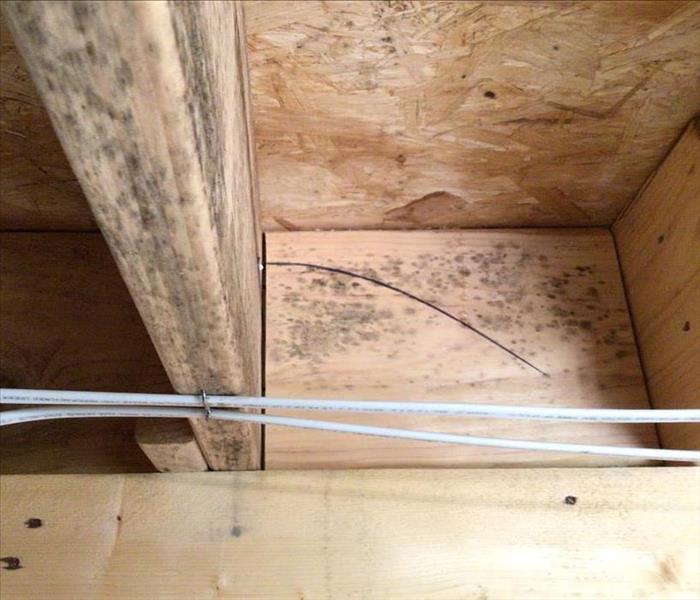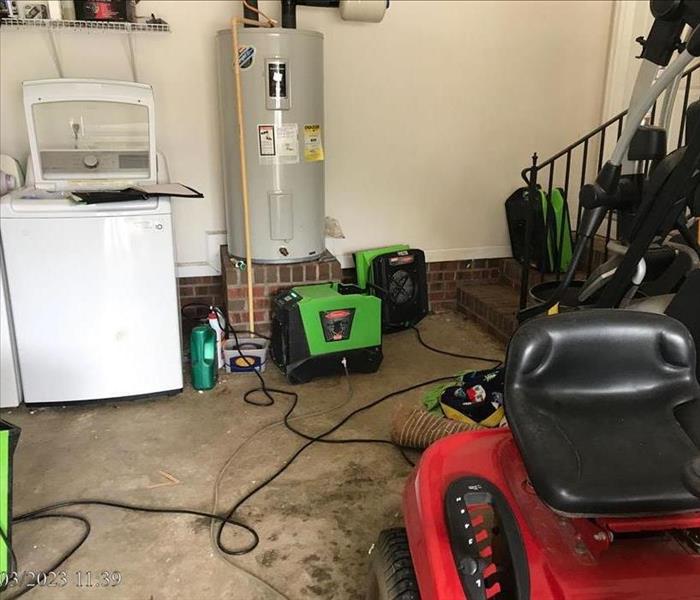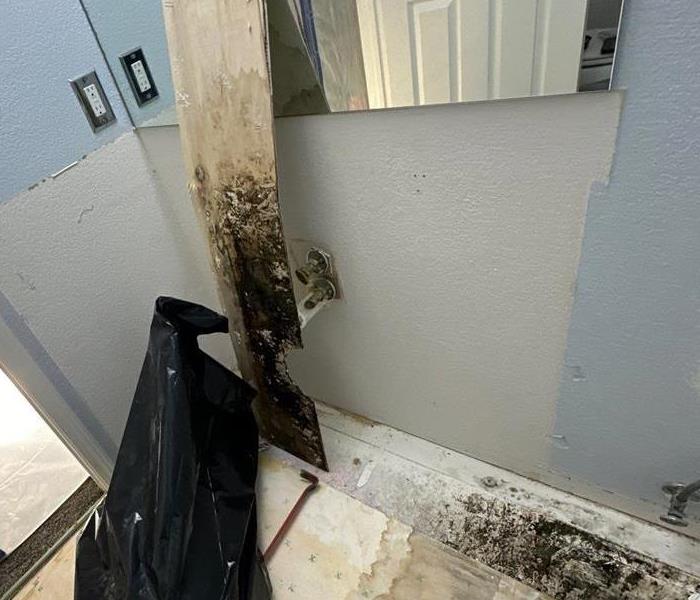Archived Mold Remediation Blog Posts
Mold and Moisture Control in Commercial Buildings: Prevention Strategies and Professional Solutions
11/20/2024 (Permalink)
Mold and moisture can be significant issues in commercial buildings, leading to structural damage and costly repairs if not properly addressed. Mold thrives in damp environments, making moisture control essential to maintaining the integrity and longevity of commercial properties. Without adequate prevention and remediation measures, mold can spread rapidly, especially in large buildings with complex HVAC systems, high foot traffic, and areas that may be prone to moisture buildup.
In this blog, we’ll explore the importance of mold and moisture control in commercial buildings, key strategies for prevention, and how professional remediation services like SERVPRO® can help protect your investment.
Why Mold and Moisture are Serious Threats to Commercial Properties
Commercial buildings are often larger and more complex than residential properties, with many hidden areas where moisture can accumulate unnoticed. Roof leaks, plumbing issues, or improper ventilation can create conditions where mold can flourish. Mold can damage materials like drywall, wood, and ceiling tiles, which may lead to structural issues if not caught early.
In addition to visible damage, mold spores can also spread through HVAC systems, affecting large areas quickly. Without adequate control measures, the cost of repairs can escalate rapidly. This is why mold and moisture control must be a top priority for building owners and facility managers.
Strategies for Mold and Moisture Control in Commercial Buildings
Identify and Fix Moisture Sources
One of the most important steps in preventing mold growth is identifying and fixing sources of moisture. Common causes of moisture buildup in commercial buildings include:
- Leaking Roofs: Water can seep into ceiling materials and insulation, providing a perfect environment for mold to grow.
- Plumbing Leaks: Pipes that are cracked, broken, or not sealed properly can lead to undetected water leaks in walls, ceilings, or floors.
- Poor Ventilation: Inadequate ventilation can result in humidity and moisture buildup, particularly in areas such as kitchens, bathrooms, and basements.
Regular inspections can help identify potential problem areas before they become major issues. Addressing water leaks and ventilation problems immediately can prevent mold from spreading.
Maintain HVAC Systems
HVAC systems play a critical role in regulating moisture levels in commercial buildings. Proper maintenance of HVAC systems helps ensure that excess moisture is removed from the air, preventing mold growth. Key maintenance tasks include:
- Regular filter changes: Dirty filters can restrict airflow and lead to moisture buildup in ducts.
- Routine inspections: Checking for leaks or moisture accumulation in the ductwork can prevent mold spores from circulating through the building.
- Proper dehumidification: In high-humidity climates, using dehumidifiers or adjusting the HVAC system to remove excess humidity is essential..
Improve Building Drainage
Water pooling around the foundation or in other areas of the building can lead to moisture problems inside. It’s important to have a well-designed drainage system to channel water away from the building.
Ensure that:
- Gutters and downspouts are clear and direct water away from the foundation.
- The grading around the building slopes away to prevent water from accumulating near the base.
- Flood-prone areas are protected, especially in regions with frequent storms or heavy rainfall.
Use Mold-Resistant Materials
For areas that are frequently exposed to moisture, such as restrooms, kitchens, and basements, using mold-resistant materials can help prevent mold growth. These materials include:
- Mold-resistant drywall: This type of drywall contains moisture-resistant backing and is less prone to mold growth.
- Mold-resistant paint: Adding mold inhibitors to paint can help prevent mold from forming on surfaces.
- Non-porous materials: Surfaces made from non-porous materials like tile, stainless steel, or treated wood are less likely to absorb moisture and foster mold.
Regular Inspections and Maintenance
Routine inspections and maintenance of your commercial building are crucial for preventing mold. Regularly inspecting high-risk areas, such as basements, storage rooms, kitchens, bathrooms, and HVAC systems, can help catch moisture and mold problems early.
Facility managers should:
- Inspect roofs, windows, and doors for leaks or signs of water damage.
- Check for condensation in areas with temperature fluctuations, like near windows or HVAC equipment.
- Inspect pipes and plumbing systems for signs of leaks, corrosion, or water stains.
The Importance of Professional Mold Remediation
Even with the best prevention strategies, mold can still become a problem in commercial buildings. Once mold has taken hold, it requires professional remediation to completely remove and prevent it from returning.
SERVPRO provides expert mold remediation services tailored to the unique needs of commercial properties. Our team uses advanced techniques and equipment to identify the source of moisture, contain mold growth, and safely remove it from affected areas.
For comprehensive mold remediation services, SERVPRO of Harnett County East and Sampson County North is your trusted partner in restoring your commercial property and keeping it mold-free. With our expertise, we can help you manage mold issues quickly and effectively, ensuring your building remains safe and structurally sound.
Where to Check for Mold Before Starting Home Renovations
7/17/2024 (Permalink)
 If you suspect mold in your renovation areas or need expert advice, don’t hesitate to contact our professional team.
If you suspect mold in your renovation areas or need expert advice, don’t hesitate to contact our professional team.
Starting a home renovation is an exciting venture, but it's crucial to tackle any potential issues before they become bigger problems down the line. One such issue is mold. Mold not only damages your property but can also complicate your renovation plans. Identifying and addressing any mold issues before you begin can save time, money, and hassle. Here’s where to check for mold prior to starting your renovations.
1. Bathrooms and Kitchens
These areas are the most common breeding grounds for mold due to their high moisture levels. In the bathrooms, check around the sink, bathtub, and toilet. Look for any discoloration or black spots on walls, ceilings, and around plumbing fixtures. In kitchens, inspect areas under the sink and around the dishwasher and refrigerator. Don’t forget to examine exhaust fans and ventilation systems that can harbor mold spores.
2. Basements and Crawl Spaces
Basements and crawl spaces often suffer from poor ventilation and water intrusion, which can create ideal conditions for mold growth. Check for signs of moisture or water damage, such as water stains, peeling paint, or warping. Inspect floor joists and behind any stored items where moisture can accumulate unnoticed.
3. Windows and Door Frames
The seals around windows and doors are common places for moisture to enter and get trapped, creating a perfect habitat for mold. Check these areas thoroughly for any signs of mold, mildew, or rot. Pay attention to any soft spots or discoloration in the wood or drywall around these frames.
4. Attics
Attics can be susceptible to mold growth due to roof leaks or inadequate ventilation. Examine the insulation, rafters, and sheathing for any signs of mold or moisture. Be sure to inspect around roof vents and chimneys where leaks might occur.
5. HVAC Systems
Your heating, ventilation, and air conditioning system can distribute mold throughout your house. Check the air ducts, intake vents, and drip pans for any signs of mold. It’s crucial to ensure these systems are clean and functioning correctly to prevent mold spread during and after renovations.
6. Behind Drywall and Paneling
Mold can grow undetected behind walls, particularly if there has been previous water damage. During renovations, it might be necessary to remove sections of drywall or paneling to check for hidden mold. This is especially important if you’ve experienced flooding or have noticed a musty smell in any area of your home.
7. Flooring
Whether it’s carpet, hardwood, or linoleum, the flooring can harbor mold beneath its surface, especially in areas prone to dampness. Before laying new floors or carpet, ensure that the subflooring is thoroughly inspected and treated for any mold or moisture.
Checking these areas for mold before starting renovations is essential for a successful project. Ignoring mold can lead to significant damage and expensive repairs in the future. If you do find mold, it’s advisable to handle it professionally before proceeding. At SERVPRO®, we specialize in mold remediation and can help ensure that your renovation project starts on the right foot.
If you suspect mold in your renovation areas or need expert advice, don’t hesitate to contact our professional team. We’re here to help your renovations go smoothly by tackling the tough issues head-on.
Mold and Renovations: Tips for a Mold-Free Makeover
3/13/2024 (Permalink)
 In this blog, we will explore tips and steps to ensure a mold-free makeover for your home.
In this blog, we will explore tips and steps to ensure a mold-free makeover for your home.
Renovating your home can be an exciting and rewarding experience. However, it is essential to be aware of potential mold issues that may arise during the renovation process. Mold damage can be a common occurrence during home renovations, especially if moisture sources are disturbed. In this blog, we will explore tips and steps to ensure a mold-free makeover for your home.
Before Starting the Renovation
Here are a few steps to take before beginning your renovation:
- Inspect for Existing Mold: Before beginning any renovation, thoroughly inspect your home for any signs of mold. Look for discoloration, musty odors, or any visible mold growth. If mold is found, it is crucial to address it and carry out mold remediation before proceeding with renovations.
- Address Moisture Issues: Identify and address any potential moisture sources in your home, such as leaks or inadequate ventilation. A dry and moisture-free environment is essential for preventing mold growth during renovations.
- Plan Proper Ventilation: Ensure proper ventilation in areas where renovations will occur. Well-ventilated spaces help maintain adequate air circulation and prevent excess humidity, reducing the risk of mold growth.
During the Renovation Process
- Containment Measures: If you are making changes in areas where mold is present, it is important to implement proper containment measures. This can include using plastic sheeting to isolate the work area and setting up negative air pressure machines to prevent mold spores from spreading to other parts of the home.
- Moisture Control: During renovations, avoid creating excess moisture. Ensure that water sources are properly sealed off and that surfaces are kept dry. Wipe up any spills promptly, and use dehumidifiers or fans to control humidity levels.
- Proper Removal of Mold-Infested Materials: If mold is found during renovations, it is crucial to remove mold-infested materials properly. Doing so reduces the risk of spreading mold spores and prevents further contamination.
- Effective Cleaning: Clean the renovation area thoroughly, especially after any mold removal. Use appropriate cleaning techniques and antimicrobial products to eliminate any remaining mold spores and ensure a mold-free environment.
After the Renovation
- Final Inspection: After renovations are complete, perform a final inspection to ensure that there are no signs of mold or moisture issues. Look for any signs of water damage, discoloration, or musty odors. If any issues are identified, address them promptly to prevent mold growth.
- Maintain Proper Ventilation: Maintain good ventilation and airflow throughout your home even after renovations are complete. This will help prevent excess moisture buildup and reduce the risk of mold growth.
- Regular Maintenance: Regularly inspect your home for any signs of water leaks, moisture buildup, or mold growth. Address these issues immediately to prevent further damage and keep your home mold-free.
Professional Mold Remediation
If you encounter significant mold damage or are unsure of how to properly address mold during renovations, it is recommended to seek professional mold remediation services. Professional mold remediation experts have the knowledge, experience, and specialized equipment to handle mold issues effectively and safely.
Renovating your home can be an exciting process, but it is essential to be mindful of potential mold issues. By following the tips and steps provided, you can help ensure a mold-free makeover for your home. Proper inspection, addressing moisture issues, implementing containment measures during renovations, effective cleaning, and ongoing maintenance will help prevent mold growth and maintain a healthy living environment. Consider seeking professional mold remediation services for any significant mold damage or if you are unsure how to handle mold during renovations.
Why Mold Remediation is Best Left to the professionals
7/5/2023 (Permalink)
Dealing with mold growth in your home can be a daunting and concerning experience. While it may be tempting to tackle the problem yourself, it's essential to understand the complexities of mold remediation and the importance of hiring professionals to handle the job. In this article, we'll explain why leaving mold remediation to the experts at SERVPRO of Harnett County East and Sampson County North is the wisest decision for a thorough and effective solution.
Identifying Hidden Mold: Mold can often hide in hard-to-reach areas, such as behind walls, under flooring, or within HVAC systems. Trained professionals possess the expertise and specialized equipment to detect hidden mold growth. By conducting a comprehensive inspection, they can identify the full extent of the problem, ensuring that no mold goes unnoticed.
Proper Containment and Protection: During the mold remediation process, it's crucial to prevent the spread of mold spores to unaffected areas of your home. Professionals use advanced containment techniques, including physical barriers and negative air pressure, to confine the mold-infested areas. They also wear protective gear to safeguard themselves and prevent cross-contamination.
Thorough Mold Removal: Removing mold effectively requires specialized techniques and equipment. Professionals at SERVPRO of Harnett County East and Sampson County North have the knowledge and tools to safely and thoroughly remove mold, including the use of HEPA vacuums, antimicrobial treatments, and professional-grade cleaning agents. They ensure that all affected materials are properly handled and disposed of, minimizing the risk of future mold growth.
Addressing the Root Cause: Mold growth is often a symptom of an underlying issue, such as water leaks, high humidity, or inadequate ventilation. Professionals not only remediate the mold but also address the root cause of the problem. They will identify and repair water sources, improve ventilation, and provide recommendations to prevent future mold growth, helping you maintain a normal living environment.
Time and Cost Efficiency: Attempting to tackle mold remediation on your own can lead to delays, mistakes, and potentially higher costs in the long run. Professionals have the experience, skills, and resources to efficiently complete the remediation process, saving you valuable time and ensuring a thorough job. Moreover, they can help you navigate insurance claims and provide documentation for your records.
When it comes to mold remediation, it's essential to prioritize your family's health and the well-being of your home. Trusting the professionals at SERVPRO of Harnett County East and Sampson County North ensures a comprehensive, safe, and effective solution to your mold problem. With their expertise, advanced techniques, and dedication to customer satisfaction, they will restore your home to a clean and mold-free state. Don't take chances with mold—rely on the experts who are just a call away!

 24/7 Emergency Service
24/7 Emergency Service


